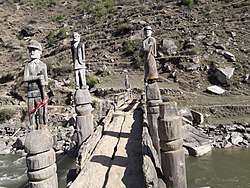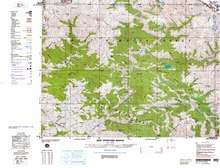Jumla District
Jumla District (Nepali: जुम्ला जिल्ला![]()
Jumla District जुम्ला जिल्ला | |
|---|---|
District | |
 Wooden craft at Sinja Valley in Jumla | |
 Location of Jumla District (dark yellow) in Karnali Province of Nepal. | |
| Coordinates: 29.275278°N 82.183333°E | |
| Country | |
| Province | Karnali Pradesh |
| Admin HQ. | Jumla |
| Municipality | |
| Government | |
| • Type | Coordination committee |
| • Body | DCC, Jumla |
| • Parliamentary constituencies | 1 seats List
|
| • Provincial constituencies | 2 seats List
|
| Area | |
| • Total | 2,531 km2 (977 sq mi) |
| Highest elevation | 4,679 m (15,351 ft) |
| Lowest elevation | 915 m (3,002 ft) |
| Population (2011)[2] | |
| • Total | 108,921 |
| • Density | 43/km2 (110/sq mi) |
| Demographics | |
| • Ethnic groups | Chetri, Bahun, Thakuri |
| • Female ♀ | 50% |
| Human Development Index | |
| • Literacy | 55% |
| Time zone | UTC+05:45 (NPT) |
| Postal Codes | 21200, 21202, 21204, 21205..., 21209 |
| Telephone Code | 087 |
| Main Language(s) | Nepali |
| Major highways | Karnali |
| Website | daojumla.moha.gov.np ddcjumla.gov.np |
The Nepali language (then known as Khas language) originated in the Sinja Valley. Sinja was the capital of Khas Kingdom, and the dialect called "Khas Bhasa" is still spoken among that region's people.[5]
History
Khasa Kingdom
Jumla was a part of Khasa kingdom during 11th to 13th century. After 13th century Khasa Kingdom collapsed and divided into Baise Rajya (22 principality) in Karnali-Bheri region and Kingdom of Jumla was one of them.
Kingdom of Jumla
The Jumla Kingdom was one of the many kingdoms that dotted Nepal before its reunification by King Prithvi Narayan Shah of Gorkha and later by his younger son Bahadur Shah. The kingdom was founded around 1404 when Baliraja, who married the daughter of the last ruler of the Yatse (Malla) Kingdom, succeeded his father-in-law.[6] It was one of the most powerful kingdoms in western Nepal, being one of the 22 Baise principalities of the Karnali region which had once been part of the larger Yatse Kingdom. After centuries of intermittent warfare it appropriated the kingdom of Mustang in 1760.[7] In the late 18th century the Jumla kingdom successfully defended itself against the first attack by King Prithivi Narayan Shah, and legend even has it that he got injured in the battle. Later, with the help of the kingdoms surrounding Jumla, Bahadur Shah attacked again and annexed Jumla for the Gorkha kings in 1789.[8] The Jumla kings were Thakuris (Sijapati, Malla, Shahi) like the Gorkha Kings.
The Jumla Kingdom belonged to the more extensive pre-unification kingdoms in Nepal. At the height of its power it extended from Mustang in the east to present day Uttarakhand, a state in modern-day India, territory that Kingdom of Nepal lost to the East India Company in 1816 during the partition of Nepal.[9] The Jumla kings belonged to the Kalyal dynasty, linked to the Mewar clan of Rajasthan, India. There have also been marriages between the Jumla royal family and the Shah's royal family of Nepal. The direct descendants of the erstwhile Jumla royal family include currently, Nepali Film legend Nir Shah, Former Director General of Nepal Electricity Authority Harish Chandra Shah, DIGP (Retd) Sher Bahadur Shah, Colonel Nepal Army (Retd.) Bhim Bahadur Shah and AIGP (Retd.) of Nepal Police, Surendra Bahadur Shah.
Kings of Jumla
The kings of Jumla, post-1400:[10]
- Baliraja 1404-1445
- Vaksaraja 1445-? (son)
- Vijayaraja (son)
- Visesaraja fl. 1498 (son)
- Vibhogaraja (?)
- Matiraja (?)
- Sahiraja (?)
- Bhanasahi c. 1529-90 (son)
- Saimalsahi c. 1590-1599 (son)
- Vasantaraja 1599-1602 (son)
- Visekaraja 1599-1602 (brother)
- Vikramasahi 1602-c. 1635 (brother)
- Bahadurasahi c. 1635-65 (son)
- Virabhadrasahi 1665-75
- Prithvipatisahi 1676-1719 (son)
- Surathasahi 1719-40 (son)
- Sudarasanasahi 1740-c. 1758 (son)
- Suryabhanasahi c. 1758-89 (son)
Geography and Climate

Geographically, Jumla is a Himalayan mountainous region of which elevations ranges from 915 metres (3,002 ft) to 4,679 metres (15,351 ft). The Higher Himalyan Region consists of Patarasi and Kanjirowa Himalayan range. The major rivers in Jumla are Hima, Tila and Jawa.[11]
| Climate Zone[12] | Elevation Range | % of Area |
|---|---|---|
| Temperate | 2,000 to 3,000 meters 6,400 to 9,800 ft. |
25.3% |
| Subalpine | 3,000 to 4,000 meters 9,800 to 13,100 ft. |
49.7% |
| Alpine | 4,000 to 5,000 meters 13,100 to 16,400 ft. |
13.9% |
| Nival | above 5,000 meters | 7.3% |
| Trans-Himalayan | 3,000 to 6,400 meters 9,800 to 21,000 ft. |
3.8% |
Demographics
At the time of the 2011 Nepal census, Jumla District had a population of 108,921. Of these, 98.6% spoke Nepali and 0.6% Tamang as their first language.[13]
Divisions
On 10 March 2017 Government of Nepal restricted old administrative structures and announced 744 new local level units (9 added later) as per the new constitution of Nepal 2015,[14]
According to new structure Jumla district is divided into 1 municipality (urban) and 7 rural municipality:
Municipalities
- Chandannath (UM)
- Kankasundari (RM)
- Sinja (RM)
- Hima (RM)
- Tila (RM)
- Guthichaur (RM)
- Tatopani (RM)
- Patarasi (RM)
Note: UM=Urban Municipality, RM=Rural Municipality
References
- "District Administration Office Jumla".
- General Bureau of Statistics, Kathmandu, Nepal, Nov. 2012
- Districts of Nepal
- District profile of Jumla
- The origin of Nepali language is Sinja of Jumla, retrieved Feb 25, 2018
- Ram Niwas Pandey (1998) The making of modern Nepal: A study of history, art, culture of Western Nepal. Nirala Press.
- Rishikesh Shaha (1997) Ancient and medieval Nepal. New Delhi: Manohar, p. 67.
- Rishikesh Shaha (1996) Modern Nepal: A political history 1769-1955, Vol. I. New Delhi: Manohar, p. 53.
- Rishikesh Shaha (1996) Modern Nepal: A political history 1769-1955, Vol. I. New Delhi: Manohar, p. 139.
- Ram Niwas Pandey (1998) The making of modern Nepal: A study of history, art, culture of Western Nepal. Nirala Press.
- District profile of Jumla
- The Map of Potential Vegetation of Nepal - a forestry/agroecological/biodiversity classification system (PDF), Forest & Landscape Development and Environment Series 2-2005 and CFC-TIS Document Series No.110., 2005, ISBN 87-7903-210-9, retrieved Nov 22, 2013
- 2011 Nepal Census, Social Characteristics Tables
- "New local level structure comes into effect from today". www.thehimalayantimes.com. The Himalayan Times. 10 March 2017. Retrieved 17 July 2018.
External links
| Wikimedia Commons has media related to Jumla District. |
